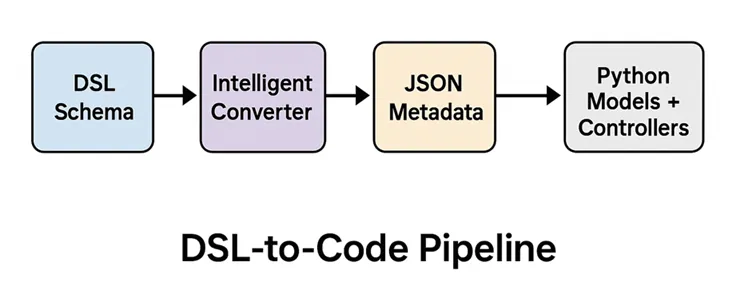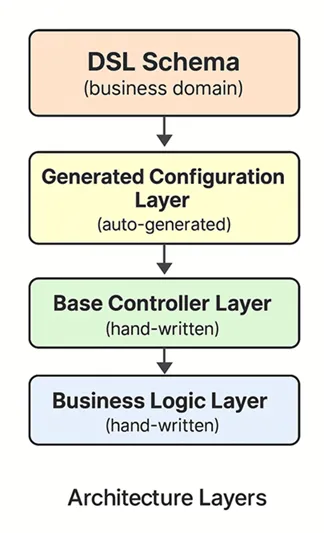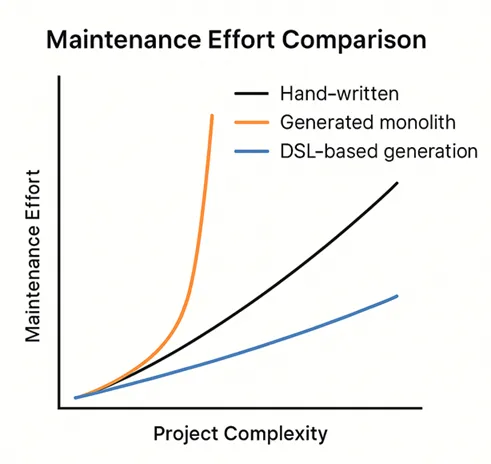Code Generation Quality Assessment: Maintainability vs. Automation Trade-offs
Analysis of quality characteristics between generated code and hand-written implementations using a real-world shipping domain case study
Published on LinkedIn • Technical Analysis
While reviewing enterprise application architectures last month, I encountered a fascinating paradox: teams spending months building CRUD operations that could be generated in minutes, yet hesitant to adopt code generation due to maintainability concerns. This led me to analyze the quality characteristics of generated code versus hand-written implementations using a real-world case study.
The Business Domain Challenge
Consider a typical shipping management system requiring complex entity relationships. The business domain includes manifests, clients, vessels, ports, and line items with intricate foreign key dependencies. Traditionally, this requires weeks of careful database design, model creation, and controller development.
However, using a domain-specific language approach, the entire business model can be expressed concisely:
table Manifest {
id Int [pk, increment]
bill_of_lading String [unique]
shipper_id Int [ref: > Client.id]
consignee_id Int [ref: > Client.id]
vessel_id Int [ref: > Vessel.id]
origin_port_id Int [ref: > Port.id]
destination_port_id Int [ref: > Port.id]
created_at DateTime [default: `now()`]
updated_at DateTime [note: 'Auto-updated']
}
table LineItem {
id Int [pk, increment]
manifest_id Int [ref: > Manifest.id]
commodity_id Int [ref: > Commodity.id]
quantity Decimal
weight Decimal
// ... additional fields
}
This 17-line DSL definition generates a complete SQLAlchemy model with relationships, indexes, audit trails, and CRUD operations—typically 200+ lines of hand-written Python code.
 Figure 1: DSL-to-Code Generation Pipeline - From business domain specification to working application components (image under review)
Figure 1: DSL-to-Code Generation Pipeline - From business domain specification to working application components (image under review)
The Maintainability Challenge
Most developers have encountered generated code that creates more problems than it solves—massive files, unreadable output, or black-box systems that break when business requirements change. The conventional wisdom suggests that generated code sacrifices long-term maintainability for short-term development speed.
However, examining the production system generated from this DSL revealed a different pattern. The generated controllers averaged just 25 lines each, while hand-written equivalents typically span 200-400 lines with embedded business logic, error handling, and database operations.
Architecture Pattern Analysis
The key insight lies in the separation strategy. Instead of generating monolithic controllers, the system produces minimal coordination code that delegates to protected base classes:
# Generated controller (manifest_controller.py - 23 lines)
from core.base_controller import BaseCRUDController
from generated.models.shipping_v2 import Manifest
class ManifestController:
def __init__(self, db_session):
self.controller = BaseCRUDController(db_session, Manifest)
self.model = Manifest
def create_routes(self, blueprint):
return BaseCRUDRoutes(
controller=self.controller,
blueprint_name='manifest_v2',
url_prefix='/v2/manifest'
)
The complex logic resides in the base classes, which are hand-written, tested, and maintained by developers. Generated files contain only entity-specific configuration and routing information.
Meanwhile, the DSL definition becomes the authoritative business domain specification. When requirements change—adding a new field or relationship—developers modify the DSL and regenerate, rather than hunting through multiple Python files to make coordinated updates.
 Figure 2: Layered Architecture - Clean separation between DSL specification, generated configuration, and hand-written business logic (image under review)
Figure 2: Layered Architecture - Clean separation between DSL specification, generated configuration, and hand-written business logic (image under review)
Custom Business Logic Integration
Maintainability improves further through the extension pattern. Custom business rules integrate cleanly without modifying generated code:
# Custom business logic (shipping_calculations.py)
class ManifestCalculations(Manifest):
def calculate_total_weight(self):
return sum(item.weight for item in self.line_items
if not item.deleted_at)
def validate_shipping_route(self):
if self.origin_port.country != self.vessel.flag_country:
return ValidationError("Cross-border shipping requires customs documentation")
The DSL-generated models provide the foundation, while custom business logic extends functionality without touching generated code. Schema changes in the DSL automatically propagate through regeneration, preserving custom extensions.
Quality Metrics Comparison
Analyzing the production system revealed interesting maintainability characteristics:
Schema Consistency: The DSL ensures all entities follow identical patterns for audit fields, soft deletes, and relationship handling—eliminating the inconsistencies common in hand-written systems.
Change Impact: Modifying the DSL and regenerating affects only the specific entities changed, with automatic relationship updates propagating correctly. Hand-written systems require manual coordination across multiple files.
Business Alignment: The DSL serves as executable documentation that business stakeholders can read and validate, reducing the translation errors between requirements and implementation.
 Figure 3: Maintenance Effort Over Time - DSL-based generation provides controlled, predictable maintenance scaling (image under review)
Figure 3: Maintenance Effort Over Time - DSL-based generation provides controlled, predictable maintenance scaling (image under review)
Trade-off Assessment
The analysis reveals that code generation quality depends heavily on the source specification and architecture pattern. DSL-based generation produces more maintainable results than template-based or visual modeling approaches because:
Advantages Observed
- Single source of truth for business domain in readable format
- Consistent implementation patterns across all entities
- Automatic propagation of schema changes with relationship integrity
- Version control integration for business domain evolution
Limitations Identified
- Base class changes affect all generated controllers
- Complex business workflows still require custom development
- Team must understand DSL syntax and generation process
- Initial setup requires architectural discipline
Future Development Patterns
This architectural approach suggests broader implications for enterprise development practices. Rather than viewing code generation as a trade-off between speed and quality, DSL-based patterns demonstrate how generation can improve maintainability through enforced consistency and business domain clarity.
The key insight is that successful code generation requires both a clear source specification (the DSL) and careful architectural boundaries between generated coordination logic and hand-written business logic. When these elements align, generated code becomes a maintainability asset rather than technical debt.
Discussion
Have you worked with DSL-based development approaches in your projects? What patterns have you found effective for maintaining clean boundaries between domain specifications and custom business logic?
I’d be particularly interested in hearing from teams who’ve evaluated the long-term maintainability trade-offs in code generation systems.
This analysis is based on a production system managing 17 interconnected business entities with complex relationship patterns. The complete technical architecture documentation and source code examples are available for review.
Tags: #SoftwareArchitecture #CodeGeneration #DomainDrivenDesign #EnterpriseArchitecture #Maintainability
Word Count: ~1,050 words
Reading Time: 4 minutes